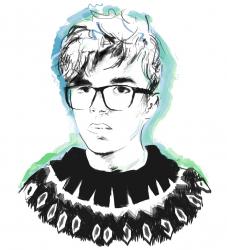It’s been five summers since Claus Sterneck, a well-known local photographer and postman in Reykjavík, first affixed photography works to the walls of the mysterious abandoned herring factory in Djúpavík, thus bringing the Steypa group photography exhibition to life. This year, Steypa steps out into the light, taking over a large greenhouse in Hveragerði and Restaurant Mika in Reykholt with new work from an international team of artists and photographers. After all, three years is a long time to spend in the shadow of the western hills.
“Steypa is the Icelandic word for concrete,” Claus explains over a crackly Facetime feed. “The herring factory was at the time the largest building in Iceland made of concrete. This year, it’s a greenhouse—the opposite of concrete—but there’s one partially damaged wall that reminds me of the place in Djúpavík. It’s falling apart. There’s still concrete in this building.”

No sunsets
Keen to distance the exhibition from the cascading, Instagram-friendly simulacra of the Icelandic landscape, Claus curates STEYPA according to three strict rules. “It must be photography. It’s okay to show text, poems, or other information—but the focus is photography. The next is that all pictures must have a connection to Iceland. The third is ‘Please, please, please: no Northern lights, waterfalls, or sunsets.’”
Iceland is now no doubt one of the most photographed places in the world, and the proliferation of amateur photographers visiting the country is forcing local artists to explore the country in new, different ways. “You see these pictures in every single guidebook about Iceland,” Claus says, almost wearily. “It’s not the photography I want to show in Steypa. I think many people coming to Iceland are so impressed and overwhelmed by the wonderful landscape that many of them miss the small details and what is beside it.”
Double-edged sword
From my conversation with Claus, I’m struck by the notion that the tourism boom has been a double-edged sword for artists in Iceland. Diminishing charm has been accompanied by increased exposure. It’s caused something of a cultural paradox.
“I’ve lived in Reykjavík since before 2008, the year of the crisis. From 2010-11 tourism has been going crazy—especially in Reykjavík. I almost never go out now. The locations aren’t so interesting anymore. Too much tourism, too many souvenir stores, too many expensive restaurants, Airbnbs, hotels, and guesthouses. It’s changed the city centre a lot.”
Of course, there are a few positive aspects. Claus gets more feedback and response from tourists, and more people coming to Iceland means more interest in art—and more interest in Steypa.

“I see it in a sculpture museum where I work,” says Claus. “We used to have five or ten guests on weekends, but now it’s fifty or eighty. It’s not even in the centre of Reykjavík and it’s a small museum. Iceland is a very creative island and I think Icelanders are very open to art and creative projects in general. Even in the countryside, there’s space for art projects and residencies. That’s something very positive. With increasing tourism these projects get more feedback and acceptance. Look at the murals in the city centre that were made last year for Airwaves. Public art is a very important aspect of the culture scene in Reykjavík and Iceland—you can see this in the sculptures around Tjörnin, and the exhibitions in Harpa and the town hall.”
Quiet moments
Underneath all the noise, it seems that there’s still a place for the small details. “These pictures are not spectacular,” says Claus. “They are calm. They don’t want to capture the big things. They want to capture daily life. The quiet moments.”
Everyday moments frozen in time become part of a much bigger narrative at Steypa. “Steypa is only as good as the pictures and ideas are,” finishes Claus. “If you only saw landscape photos, it would get boring. It’s not glaciers and sunsets… it’s nine photographers, each of us with our own stories.”

This international group of photographers—hailing from across continents, from Canada to Poland—tell a story of a landscape littered with clouds, lonely birds, electronic graveyards, and small bones. It is the uncanny, surreal, forgotten places that matter. Here, life whispers louder than the land can ever shout. Step into the greenhouse and take a moment among the plants.
Info: STEYPA runs until 31 August. Admission is free. The Hveragerði exhibit, located in a greenhouse on the campus of the Agricultural University of Iceland, is open from 08:00—16:00, Monday to Friday. The Restaurant Mika exhibition is open daily from 11:30—21:00. More info: www.steypaphoto.com
Buy subscriptions, t-shirts and more from our shop right here!























